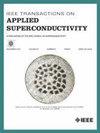Measurement and Modeling of Initial Quench Development in Nb3Sn Accelerator Magnets
IF 1.7
3区 物理与天体物理
Q3 ENGINEERING, ELECTRICAL & ELECTRONIC
引用次数: 0
Abstract
Accelerator magnets are equipped with voltage taps and, on the test bench, with so-called quench antenna's to monitor the transient effects occurring during a magnet quench. Proper identification and localization of a quench origin is vital for understanding performance issues in Nb3Sn accelerator magnets. In this paper, we describe the physical phenomena that occur during the first few milliseconds of a developing quench and how they affect the signals as intercepted with the diagnostic tools. A better understanding of these phenomena allows for better resolution on determination of the quench start location. Measurements from Nb3Sn accelerator magnets are compared with a 3D thermal-electric PEEC-FEM model of a Rutherford cable. The voltage measured over the cable shows an accelerating build-up attributed to the transverse quench propagation in the cable cross-section, which is dominated by inductive effects that results in an avalanche of quenching strands. A slow-down in the voltage build-up then indicates the point at which all strands in the cable cross-section have quenched. This phase of the quench involves a significant current redistribution that creates a magnetic dipole moment picked up by a quench antenna. The harmonic quench antenna used in this work is used to reconstruct the location, magnitude, and direction of this dipole moment, which strongly depends on the start location of the quench in the cable cross-section, on the inter-strand contact resistances and on the magneto-resistance of the copper. It is shown how the quench start location in the cable cross-section can be determined from the time integral of the reconstructed dipole moment.求助全文
约1分钟内获得全文
求助全文
来源期刊

IEEE Transactions on Applied Superconductivity
工程技术-工程:电子与电气
CiteScore
3.50
自引率
33.30%
发文量
650
审稿时长
2.3 months
期刊介绍:
IEEE Transactions on Applied Superconductivity (TAS) contains articles on the applications of superconductivity and other relevant technology. Electronic applications include analog and digital circuits employing thin films and active devices such as Josephson junctions. Large scale applications include magnets for power applications such as motors and generators, for magnetic resonance, for accelerators, and cable applications such as power transmission.
 求助内容:
求助内容: 应助结果提醒方式:
应助结果提醒方式:


